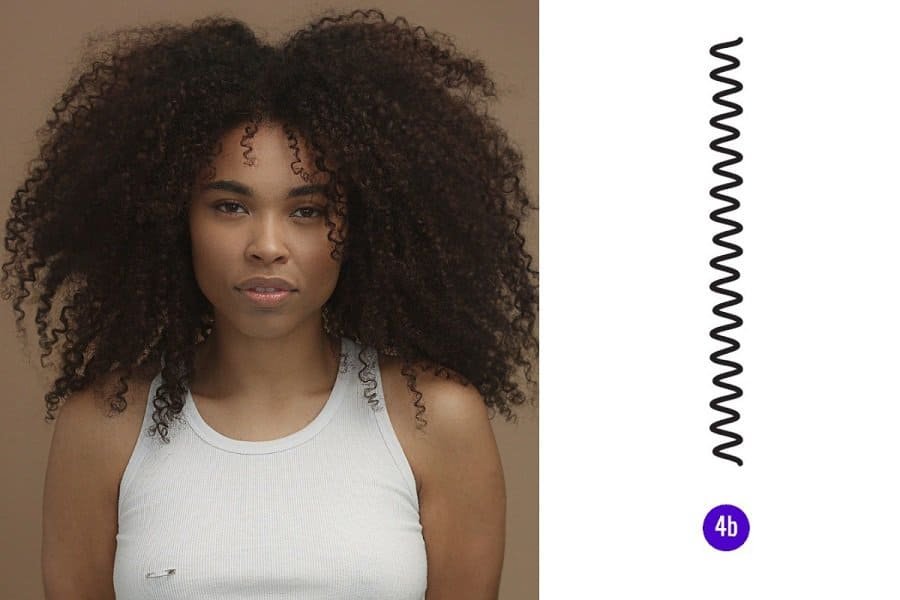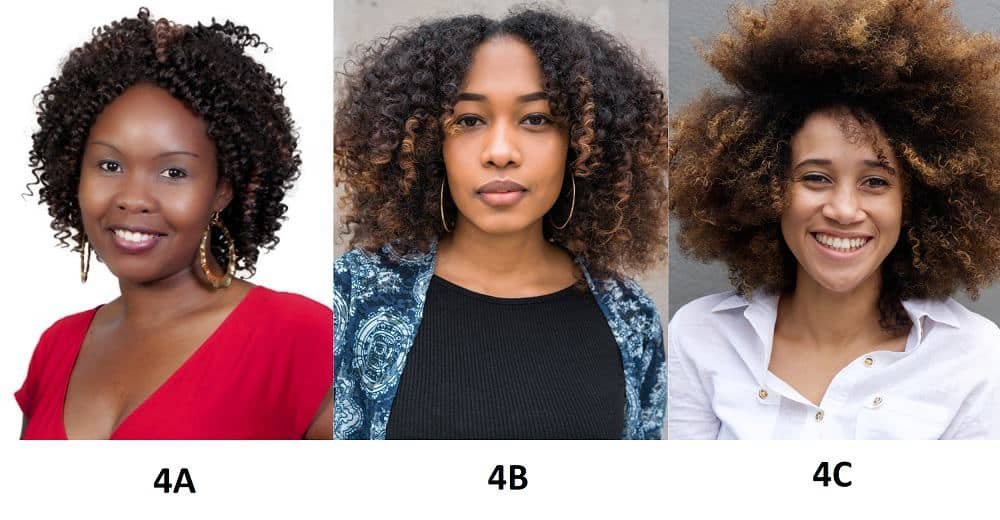If you’ve spent a lot of time in the hairstyling world, there’s a good chance that you’ve heard people refer to hair type 4 and their subtypes A, B, C. People with naturally curly hair tend to be especially familiar with the hair typing system since hair care companies use it to recommend hair products and styling tips for natural hair. But what do these hair type labels mean, and how can you tell the difference between 4A, 4B and 4C?
Let’s take a quick look at one of the most commonly used hair typing systems used in the hair industry. Then we can dive deeper into how to tell which type of hair you have and how to best style and care for it.
Andre Walker’s Hair Typing System

Andre Walker, who achieved fame as Oprah’s favorite hairstylist in the ’90s, created his hair typing system to group hair types by visible characteristics. Walker’s system labels each hair type with a letter that indicates how straight or curly the hair is, followed by a numbered subtype to denote the size of the hair’s curl pattern.
The numbers one through four indicate where your hair is in the range from straight to curly:
- Type 1: Straight
- Type 2: Wavy
- Type 3: Curly
- Type 4: Kinky/Coiled
The subtypes describe the tightness or looseness of your waves or curls using letters from A to C :
- Type A: loose
- Type B: medium
- Type C: tight
For example, a person with tight coils would be considered a 4C hair type, whereas a person with loose waves would have 2A hair. It’s not always easy to tell the difference between similar hair types – 4A vs. 4B vs. 4C hair, for example, can look pretty similar if you don’t know what to look for.
If you’re still not sure after looking at the chart, look at the differences and suggestions below to determine whether you have type 4A, 4B, or 4C hair.
Differences Between Type 4A, 4B, and 4C Hair
Most people have a mix of hair types, making it even more confusing to figure out what hair type you have. For now, let’s focus on hair types 4A, 4B, and 4C, which can be hard to tell apart at first glance.
Most African Americans have type 4 hair, which tends to be dense and springy – perfect for creating unique sculptured hairstyles, but sometimes requiring additional maintenance to prevent frizz or excessive breakage. All type 4 hair will have some similarities, of course, but each subtype has specific characteristics and care needs, so it’s essential to know which subtype you have.
Type 4A Hair

Type 4A hair forms larger, visible coils about as big around as a standard crochet needle. The coils form an S shape if you pull the end to straighten it a bit.
Care
4A hair can suffer from dryness and easy breakage, but less so than 4B and 4C. This type benefits from moisturizing treatments and curling creme to help define individual curls.
Styles
There is an endless number of styles that can be achieved with type 4A hair, whether it’s short or long. Because it naturally forms into defined curls, this hair type is especially well-suited to wash and go styles.
Type 4B Hair

Type 4B hair forms coils that are tighter than type 4A and the curl pattern has more of a crimped, zig-zag shape to it. Because the coil pattern is so much tighter, 4B hair can have up to 70% shrinkage.
Care
4B hair is drier and more prone to breakage than 4A, so it’s crucial to use treatments for strength and moisture. Using curl defining cream after washing it will help you form more defined curls.
Styles
Type 4B hair is suitable to wash and go styles, although it needs a little more work than 4A to define your curls and prevent shrinkage. Because it’s more delicate than 4A hair, it can also benefit from protective styles.
Type 4C Hair

Type 4C hair features no defined curl pattern, often clumping together at the ends rather than from root to tip, as in some other hair types. This hair type also tends to shrink quite a bit, sometimes as much as 75%.
Care
4C hair is the most delicate of the hair types and benefits significantly from frequent strengthening and moisturizing treatments.
Styles
Because it’s so fragile, type 4C hair favors protective hairstyles that keep the hair safe from unnecessary damage. Type 4C tends to be very dense, giving people with this hair type a lot of hair to work with to create impressive yet protective styles.
Ways to Tell If You Have Hair Type 4A, 4B, or 4C

Everyone’s hair is different, even if it falls into the same category. That can make it hard to tell by pictures or descriptions which category your hair belongs to. If your hair type isn’t apparent to you by reading the hair type descriptions above, you can do a couple of tests to get a better idea.
Examine Individual Strands
One way to determine your hair subtype is by examining individual strands. With this method, you’re mainly looking at the hair pattern:
- Type 4A will have a fairly consistent curl about the diameter of a standard crochet needle
- Type 4B will have a tighter and more angled, Z-shaped curl pattern
- Type 4C will have a very tight curl with no discernable pattern
When using this method, remember that not all the hairs on your head are necessarily the same subtype. It’s a good idea to look at strands from a few different areas of your scalp.
The Wet Test
The wet test involves wetting your hair and watching its behavior as it dries, so it’s a good test to try after your next shower. You’ll be looking for:
Whether your hair dries into distinct curls:
-
- 4A: will dry into defined curls with little or no help from you
- 4B: may or may not dry into defined curls on its own – might need some prompting
- 4C: will not form into defined curls on its own
How much shrinkage there is from wet to dry:
-
- 4A: will shrink less than the other types as it dries
- 4B: will shrink up to 70%
- 4C: will shrink over 70%
Ask a Professional
If you’re struggling to pin down which type of hair you have, ask a hairstylist, who will be able to give you an idea about your hair type, and also recommend styling tips and products made for type 4 hair.
Conclusion
As you can see, although it’s easy to assume that all type 4 hair is the same, that’s far from the truth. Figuring out your hair type isn’t an exact science, but this guide should get you well on your way. Taking the time to get an idea of where your hair falls in the spectrum will give you an edge when it comes to finding a hair care routine that works best for you.

